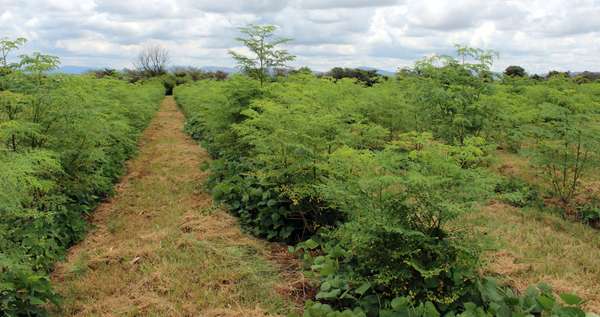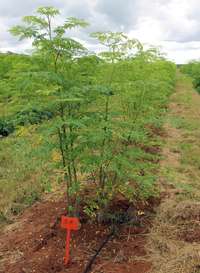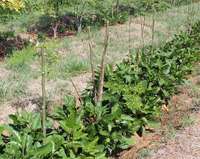This article is an outworking of ECHO research in Limpopo Province of South Africa, from 2010-2015, supported by the Howard G. Buffett Foundation. It summarizes findings published in a scientific journal by Motis et al. (2017). The original article can be found at https://doi.org/10.17660/ActaHortic.2017.1158.11. An author-created draft of the full paper is available on ECHOcommunity.org [http://edn.link/9nkm2y]. This EDN article expands on the findings of the research to include insights about establishing and maintaining moringa plantings.

Figure 1. Moringa grown with legumes planted 50 X 50 cm in a double row under the moringa trees (spaced 1 m apart). Source: Tim Motis
Moringa (Moringa oleifera) is a fast-growing tree with nutritious leaves eaten fresh or dried and converted to powder that can be added to traditional foods as a nutritional supplement. Farmers in the warm tropics can easily grow moringa. Its primary requirements are plenty of sunlight and well-drained soil. Here we address plantings of multiple rows of moringa trees, applicable to clinics, hospitals, orphanages, schools, or individual farmers producing moringa leaf powder at larger-than-household scale (Figure 1). In Niger, where there is a strong market for moringa products, plantings range in size from 0.2 to 1 ha (Pasternak et al., 2017). This article contains information on how to establish and diversify such plantings. It also addresses questions such as:
- How much leaf powder do moringa trees produce?
- What are the benefits and tradeoffs of intercropping moringa with tropical legumes?
Description of the moringa orchard trial
Plant spacing
Trees planted in rows are easier to manage than randomly placed trees. We chose to space trees 1 m apart within rows, with 3 m between rows. An in-row spacing of 1 m worked well for managing the trees as a hedge, keeping the leaves within easy reach for harvesting. With 3 m between the tree rows, we had enough space to access the trees and accommodate a second crop (in our case, a legume or vegetable).
We considered using the entire space between tree rows for the second crop. Instead, we opted to plant the second crop at the base of the moringa trees as shown in Figure 1. That way, we only had to weed, water, and fertilize a 1-m wide strip of ground below each tree row (Figure 2).
You could certainly try other spacings for the moringa trees. Pasternak et al. (2017) suggested a 2 X 2 m spacing for moringa trees grown in combination with other crops.
Legumes grown with moringa

Figure 2. A plot with no legumes under the trees, illustrating the 1-m wide band beneath moringa trees that was weeded, irrigated, and fertilized. Source: Tim Motis
In thinking about what could be grown under moringa, we selected legumes because of their ability to thrive in a variety of soils, shade weeds and provide soil-enriching mulch. Many legumes also produce edible beans. Legumes in the trial included cowpea (Vigna unguiculata), jack bean (Canivalia ensiformis; inedible without processing), lablab (Lablab purpureus), and pigeon pea (Cajanus cajan). We also included a treatment with nothing planted under the trees (Figure 2), so that we could compare moringa harvests with and without legumes. We replicated each treatment four times, with treatments randomly assigned to plots.
Planting and maintenance
Moringa trees and legumes were established with seeds planted directly into the soil. An alternative approach to planting moringa would have been to sow the seeds into plastic pots or sacks and then transplant resulting seedlings into the field. Transplanting works well but requires nursery space. Water was supplied as needed via drip irrigation. Fertility inputs consisted mainly of composted chicken manure applied three times per year at an application rate of 16 kg per 10-m length of tree row. Because of its deep roots, moringa usually grows well without fertility inputs (Palada and Chang, 2003), but we have found that moringa leaf production increases with added fertility (Motis and Reader, 2019). Options for fertility inputs include animal manure, compost, and/or NPK fertilizer.
We devoted Year One to establishing the trees. Over the next three years, we grew legumes (Year Two and Four) or vegetables (Year Three) at the base of the moringa trees. The vegetables grown in Year Three were a mix of kale and okra. They were damaged by hail soon after planting, so we learned the most from the legumes, which are the focus of this article.
The space between the tree rows was maintained as grass (Figure 1), which we mowed as needed. The most labor-intensive activities were, therefore, limited to the area directly beneath the trees.

Figure 3. Moringa trees pruned to a height of 1 m at harvest. Source: Tim Motis
Harvest and pruning
Beginning in Year Two, moringa trees were harvested twice per year. At each harvest, the trees were pruned to a height of 1 m, to stimulate leaf production and keep leaves within easy reach. 1
We placed a thick layer of straw at the base of the trees shortly after the second harvest each year. This was done to protect them from freezing temperatures during the winter. We removed the straw each spring, so that it would not be a factor affecting moringa growth during the growing season.
During Years Two and Four, we harvested legume pods every two weeks, from the time that mature pods were first observed until the final moringa harvest (the beginning of winter). At the final moringa harvest, we also collected and weighed above-ground legume growth from 1 square m in each plot.
What we learned
About moringa productivity without legumes
Calculate total number of 5-g doses: 255,000 g x dose/5 g = 51,000 doses
Calculate number of people supplied with a daily dose over a year (there are 365 days in a year, so each person needs 365 doses): 51,000 doses x person/365 doses =139.7 (round down to 139).
People often ask how much leaf powder to expect from their moringa trees. Table 1 shows the sum of our two harvests during each year. During the second year after seeding, with no legumes, the moringa trees produced a total of 76 g/tree of leaf powder, the equivalent of 255 kg/ha. That means that, during a second year after seeding, 1 ha of a moringa planting like ours can produce a year’s worth of leaf powder for 139 people consuming 5 g of powder per day. 2 Witt (2013; [http://edn.link/ern1]) provides the nutritional content for 5 g (15 mL or 1 tablespoon by volume) of moringa powder, an amount described as a realistic serving size.
| Moringa leaf powder yield (kg/ha) | ||
|---|---|---|
| Legume | Year 2* | Year 4* |
| None | 255 | 473 a |
| Cowpea | 235 | 274 bc |
| Jack bean | 253 | 206 bc |
| Lablab | 223 | 191 d |
| Pigeon pea | 279 | 340 b |
| P value** | 0.8725 | <0.0001 |
| Dry, above-ground legume biomass (kg/ha) | ||
| Legume | Year 2* | Year 4* |
| Cowpea | 762 d | 1047 b |
| Jack bean | 1180 c | 4753 a |
| Lablab | 6380 a | 3961 a |
| Pigeon pea | 2860 b | 1588 b |
| P value** | <0.0001 | <0.0001 |
| Dry grain yield of legumes (kg/ha) | ||
| Legume | Year 2* | Year 4* |
| Cowpea | 360 b | 212 c |
| Jack bean | 364 a | 1466 a |
| Lablab | 316 b | 525 b |
| Pigeon pea | 34 c | 1 d |
| P value** | <0.0001 | <0.0001 |
| *The published manuscript refers to seasons. The term “year” is used here since there was only one growing season per year. Year two and year four correspond to the first and second years of legume intercropping, respectively. | ||
| **Within each column, at least two values for a measured parameter (e.g., second-year moringa yield) are statistically different if p < 0.05, in which case any two values are statistically similar unless they share no letters in common. | ||
Each year’s moringa leaf production came from regrowth of stems close to the ground, due to winter freezes that killed growth above the straw mulch. Expect more productivity where year-round growth is possible. For example, moringa trees at the ECHO Global Farm in Florida, following a year of establishment after seeding, produced 51 to 108 g/tree of dry leaf matter every three months (Motis and Reader, 2019 3).
With no legumes, moringa powder production increased from 255 kg/ha in Year Two to 473 kg/ha in Year Four. This shows that moringa leaf production can increase with time, over a period of at least four years. In Niger, the ‘PKM 1’ cultivar of Moringa oleifera (the same cultivar grown in this trial) is said to grow well for four years, after which the trees need to be replaced (Pasternak et al., 2017). Replacement of trees is something to consider if your older trees no longer produce as much leaf material as they did in previous years. Instead of replacing all of the trees at once, you could replace under-performing trees on a yearly basis, thereby avoiding major disruptions in leaf production.
About moringa productivity with legumes
We realized that the legumes could compete with moringa for resources such as light, nutrients and water. This was indeed the case when legumes were intercropped with moringa for the second time (Year Four of trial). We think higher early-season rainfall in Year Four than Year Two benefitted the legumes more than moringa, making the legumes more competitive. Year-Four legume canopies were generally the same height (1 m) as the moringa trees after first-harvest pruning; thus, they were tall enough to shade new moringa growth. That was not the case in Year Two when the legume canopies were only about 0.5 m tall.
Of the four legumes, lablab reduced Year-Four moringa productivity the most. Moringa leaf yields were 59% less with lablab than with no intercrop. Lablab vines climbed the moringa trees, competing with the trees for light. Cowpea and pigeon pea had the least impact on Year-Four moringa powder production, but reduced moringa yields that year by 42% and 28%, respectively. These results shed light on a few ways to minimize moringa/legume competition:
- Avoid legumes that are strong climbers.
- Time the planting of legumes so that they are least likely to compete with your trees.
- Prune your moringa trees higher than 1 m (perhaps try 1.25 m or 1.5 m).
- Cut the legume biomass for fodder before they reach the height at which trees are pruned.
About the productivity of legumes under moringa
Lablab and jack bean produced more biomass than cowpea and pigeon pea. Biomass could be a source of mulch for the moringa trees or nearby gardens, or it could be cut and carried to livestock. Legumes that produce a lot of biomass shade weeds but are also the most likely to compete with your main crop.
Jack bean produced the most grain. Jack bean seeds, however, are not edible without careful processing (Hall, 2019). Of the remaining legumes, cowpea and lablab were the best grain producers. Our cowpea yield of up to 360 kg/ha was comparable to production levels of 300 kg/ha in Niger, but lower than the global average of 610 kg/ha (Rawal and Navarro, 2019). Our highest lablab grain yield of 525 kg was within the range of 327 to 612 kg/ha of grain yield reported for lablab in Tanzania (Nord et al., 2020).
Concluding thoughts
Moringa grows fast and competes with underlying crops for light. Managing rows of moringa trees as a hedge, through periodic pruning, reduces shading of any underlying crop. We saw that tropical legumes thrive at the base of moringa hedgerows, to the point that they reduced total moringa powder production during one of two seasons. I suggest growing moringa alone, until the trees are established. You could then try growing one or more other crops under your trees that you think could be useful. There may well be tradeoffs. For example, you may be willing to accept some loss in moringa productivity in exchange for weed suppression, mulch, and extra grain from legumes.
If you want to grow legumes under moringa, try growing the legume(s) you are interested in under a few trees until you know their effect on moringa leaf production. Take previously-mentioned steps to minimize competition. You could also consider growing non-legumes under moringa. Others have succeeded with lemon grass (Cymbopogon citratus; Palada et al., 2008) and vegetables (Pasternak et al., 2017). If you try vegetables, consider species such as those in the Brassica family that tolerate shade. We trust the information in this article is helpful in planning your moringa planting.
References
Hall, Z. 2019. How to process jack bean (and other types of beans) as human food. A Feed the Future brief. http://edn.link/zgqwfx
Motis, T.N., J.M. Longfellow, A.D. Jani, B.J. Lingbeek, C.J. D’Aiuto, and J.C.J. Bergen. 2017. Productivity of Moringa oleifera augmented with intercropped tropical legumes. Acta Horticulturae 1158:85-95.
Motis, T.N. and S.M. Reader. 2019. Moringa oleifera leaf production with NPK fertilizer and composted yard waste. Acta Horticulturae 1253:405-412.
Nord, A. N.R. Miller, W. Mariki, L. Drinkwater, and S. Snapp. 2020. Investigating the diverse potential of a multi-purpose legume, Lablab purpureus (L.) Sweet, for smallholder production in East Africa. PLOS One 15(1):e0227739.
Palada, M.C. and L.C. Chang. 2003. Suggested cultural practices for Moringa. International Cooperator’s Guide AVRDC (The World Vegetable Center) publication # 03-545:1-5.
Palada, M.C., Crossman, S.M., and O’Donnell, J.J. (2008). Integrating high value crops into agroforestry systems in the tropics with focus on alley copping. General Technical Report (USA: Southern Research Station, USDA Forest Service), 106, 93–101.
Pasternak, D., J.D.H. Keatinge, and Z. Mamoudou. 2017. Moringa research and cultivation in Niger. Acta Horiticulturae 1158:171-177.
Rawal, V. and D.K. Navarro (eds). 2019. The global economy of pulses. Rome, FAO.
Witt, K.A. 2013. The nutrient content of Moringa oleifera leaves. ECHO Research Note 1(1).
Cite this article as:
Motis, T. 2021. Moringa Productivity with Legume Intercropping. ECHO Development Notes no. 153.